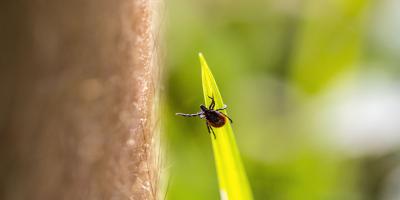They're Baaack

Actually… they never left. That’s right. Contrary to popular belief (or hope!) ticks do not actually die in the winter; nor do they hibernate. They are, in fact, present year-round, albeit out of sight. While we weathered the winter months by shoveling snow, salting the roads, and scraping ice from our windshields, the tick population sheltered under snow cover. Out of sight, and certainly out of mind for most of us.
Fortunately, professionals like us can’t ever forget about the threat of ticks and that’s why we’re alerting you to the fact that now is just about the time the dreaded ticks will be waking up to feed. If it all sounds like the plot structure to a horror movie, that’s because it kind of is when you consider the threat of Lyme and other diseases presented by tick populations, particularly here in New England.
The good news is that while the ticks never left… neither did we. Our team is here to impart some important information about the state of the upcoming tick season, along with what you can do to safeguard yourself against it.
A Tick for All Seasons
From now on, you’ll remember that ticks are not just a summer or fall threat, but can be found active any time of year, especially for those of us who enjoy spending time outdoors. While a tick’s primary feeding seasons are spring, summer, and fall, they have adapted to survive the winter. How they do it depends on their specific species.
The “winter tick” is completely unphased by winter weather or temperature drops, provided its host, which it lives on exclusively, isn’t bothered either. The heat from this single host is enough to protect a winter tick from extreme cold and so it survives from one season to the next without needing to change its behavior or seek a different source of shelter.
Blacklegged “deer” ticks and dog ticks go dormant; this is not the same as hibernation, which is reserved for some warm-blooded animals; however, it does describe a similar level of inactivity. In fact, the snow provides them with insulation, particularly if it piles up on leaf debris. This is why these ticks seek out leaf litter in the fall months, as refuge in which to wait out the winter (and why mom always warned us against jumping in leaf piles as kids!).
Meanwhile, another species, the “soft-shell” tick will keep warm in underground dens or burrows until the ground thaws and more temperate weather returns.
Granted, it’s fairly uncommon to hear of people suffering tick bites during the wintertime. That’s because ticks will not feed when the temperature falls below forty-five degrees. However, though they may be fleeting, we do have winter days that push the mercury above that benchmark, meaning you could still encounter a tick and suffer a bite.
All told, tick prevention and protection is important all year long.
When Pests Meet a Pandemic

If you live in a well-wooded area or, like many of us, you couldn’t quite keep up with all the leaf litter before the snow started to fall, you are most at risk for high tick populations on your own turf.
We all know 2020 was a year for the books. An unanticipated consequence of social distancing and widespread business closures, specifically bars and restaurants, was an increase in rodent populations, especially in major cities.
Unfortunately, the numbers don’t lie and the equation is very simple. More rodents mean more tick nymphs, which means more ticks that survived to adulthood and are now eager to feed on us this season.
The Troubling Truth About Ticks
Certain types of pests are just that… pests. Nuisances and nothing more.
This is not the case when it comes to ticks, which can transmit illnesses like Rocky Mountain Spotted Fever, ehrlichiosis, tularemia, and the rare but potentially fatal Powassan virus. Most commonly, tick bites are responsible for the transmission of Lyme disease and cases are on the rise.
According to the Centers for Disease Control and Prevention (CDC), an estimated 476,000 people contract Lyme disease in the US every year, which totals 4.28 million cases in the last nine years, a significant increase from the organization’s original estimate of 2.7 million between 2010-2018.
Lyme disease remains the most common vector-borne disease in the United States and, as these numbers show, infections are increasing, making tick prevention more critical than ever.
Lessen the Likelihood of a Tick Encounter

Safeguarding your home and family from ticks involves understanding the symbiotic relationship between ticks and mice. A symbiotic relationship simply means a close relationship between species in which one species benefits. In this case, the beneficiary is the tick. Without mice and other kinds of rodents, tick nymphs cannot feed or move from place to place as easily. For this reason, any efforts to prevent ticks need to also target mice.
An increasingly popular DIY project for mice and tick prevention is called a tick tube. You can easily assemble a tick tube from items around your home. All you need is a cardboard tube from an empty paper towel roll and cotton balls that have been treated or sprayed with permethrin, which is a natural pesticide derived from the chrysanthemum flower. Mice use these tubes, specifically the cotton within them, to build their nests. The exposure to permethrin is toxic to ticks and cuts down their mice-related populations.
It’s important to note that this DIY method has a shortcoming in that ticks will find other rodent hosts like moles, squirrels, rats or shrews.
Give Ticks the Pro Treatment
Whatever methods you use, ultimately, the promise of pest management depends on preparation. While DIY methods are helpful, the most effective measures require the full-time commitment and expertise of professional pest management. This is especially true when it comes to controlling dangerous pests like ticks. A single tick can be life-changing to its victim.
With professional tick management you invest in your own peace of mind and confidence that you have access to the most effective pest control, designed to deliver expertise and knowledge in a convenient, consistent manner.
At JP Pest Services, we’re so confident in our process and trained service pros that we back our services with a full warranty, meaning that if any ticks break through our barrier, we’ll be back out to treat at no additional cost to you.
Are you doing everything you can to keep your family safe? We’re here to help. Contact us today for a free quote, and receive $50 off your first service.*
*New services only. Restrictions and limitations may apply. Contact a customer support specialist for details. Offer valid through 6/30/2021.



